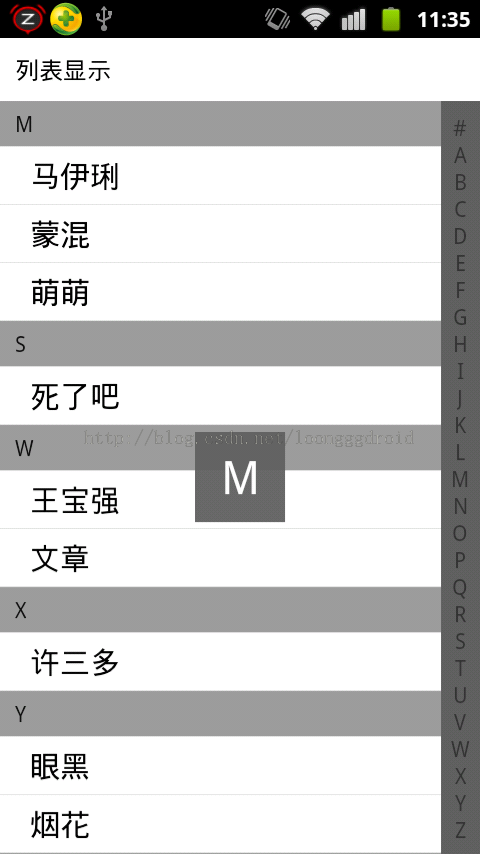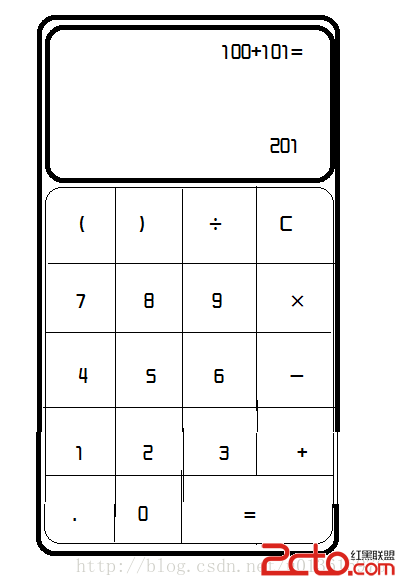編輯:關於Android編程
喜歡另辟蹊徑的我,在這裡廢話不多說了,直接上代碼和圖片了。
效果圖如下:

第一步:MainActivity的代碼如下:
package net.loonggg.test;
import java.util.ArrayList;
import java.util.Arrays;
import java.util.HashMap;
import java.util.List;
import java.util.TreeSet;
import android.os.Bundle;
import android.app.Activity;
import android.graphics.Color;
import android.view.MotionEvent;
import android.view.View;
import android.view.View.OnTouchListener;
import android.view.Window;
import android.widget.LinearLayout;
import android.widget.ListView;
import android.widget.TextView;
import android.widget.LinearLayout.LayoutParams;
public class MainActivity extends Activity {
private HashMap<String, Integer> selector;// 存放含有索引字母的位置
private LinearLayout layoutIndex;
private ListView listView;
private TextView tv_show;
private ListViewAdapter adapter;
private String[] indexStr = { "#", "A", "B", "C", "D", "E", "F", "G", "H",
"I", "J", "K", "L", "M", "N", "O", "P", "Q", "R", "S", "T", "U",
"V", "W", "X", "Y", "Z" };
private List<Person> persons = null;
private List<Person> newPersons = new ArrayList<Person>();
private int height;// 字體高度
private boolean flag = false;
@Override
protected void onCreate(Bundle savedInstanceState) {
super.onCreate(savedInstanceState);
// 去標題欄
requestWindowFeature(Window.FEATURE_NO_TITLE);
setContentView(R.layout.activity_main);
layoutIndex = (LinearLayout) this.findViewById(R.id.layout);
layoutIndex.setBackgroundColor(Color.parseColor("#00ffffff"));
listView = (ListView) findViewById(R.id.listView);
tv_show = (TextView) findViewById(R.id.tv);
tv_show.setVisibility(View.GONE);
setData();
String[] allNames = sortIndex(persons);
sortList(allNames);
selector = new HashMap<String, Integer>();
for (int j = 0; j < indexStr.length; j++) {// 循環字母表,找出newPersons中對應字母的位置
for (int i = 0; i < newPersons.size(); i++) {
if (newPersons.get(i).getName().equals(indexStr[j])) {
selector.put(indexStr[j], i);
}
}
}
adapter = new ListViewAdapter(this, newPersons);
listView.setAdapter(adapter);
}
/**
* 重新排序獲得一個新的List集合
*
* @param allNames
*/
private void sortList(String[] allNames) {
for (int i = 0; i < allNames.length; i++) {
if (allNames[i].length() != 1) {
for (int j = 0; j < persons.size(); j++) {
if (allNames[i].equals(persons.get(j).getPinYinName())) {
Person p = new Person(persons.get(j).getName(), persons
.get(j).getPinYinName());
newPersons.add(p);
}
}
} else {
newPersons.add(new Person(allNames[i]));
}
}
}
@Override
public void onWindowFocusChanged(boolean hasFocus) {
// 在oncreate裡面執行下面的代碼沒反應,因為oncreate裡面得到的getHeight=0
if (!flag) {// 這裡為什麼要設置個flag進行標記,我這裡不先告訴你們,請讀者研究,因為這對你們以後的開發有好處
height = layoutIndex.getMeasuredHeight() / indexStr.length;
getIndexView();
flag = true;
}
}
/**
* 獲取排序後的新數據
*
* @param persons
* @return
*/
public String[] sortIndex(List<Person> persons) {
TreeSet<String> set = new TreeSet<String>();
// 獲取初始化數據源中的首字母,添加到set中
for (Person person : persons) {
set.add(StringHelper.getPinYinHeadChar(person.getName()).substring(
0, 1));
}
// 新數組的長度為原數據加上set的大小
String[] names = new String[persons.size() + set.size()];
int i = 0;
for (String string : set) {
names[i] = string;
i++;
}
String[] pinYinNames = new String[persons.size()];
for (int j = 0; j < persons.size(); j++) {
persons.get(j).setPinYinName(
StringHelper
.getPingYin(persons.get(j).getName().toString()));
pinYinNames[j] = StringHelper.getPingYin(persons.get(j).getName()
.toString());
}
// 將原數據拷貝到新數據中
System.arraycopy(pinYinNames, 0, names, set.size(), pinYinNames.length);
// 自動按照首字母排序
Arrays.sort(names, String.CASE_INSENSITIVE_ORDER);
return names;
}
/**
* 繪制索引列表
*/
public void getIndexView() {
LinearLayout.LayoutParams params = new LayoutParams(
LayoutParams.WRAP_CONTENT, height);
for (int i = 0; i < indexStr.length; i++) {
final TextView tv = new TextView(this);
tv.setLayoutParams(params);
tv.setText(indexStr[i]);
tv.setPadding(10, 0, 10, 0);
layoutIndex.addView(tv);
layoutIndex.setOnTouchListener(new OnTouchListener() {
@Override
public boolean onTouch(View v, MotionEvent event)
{
float y = event.getY();
int index = (int) (y / height);
if (index > -1 && index < indexStr.length) {// 防止越界
String key = indexStr[index];
if (selector.containsKey(key)) {
int pos = selector.get(key);
if (listView.getHeaderViewsCount() > 0) {// 防止ListView有標題欄,本例中沒有。
listView.setSelectionFromTop(
pos + listView.getHeaderViewsCount(), 0);
} else {
listView.setSelectionFromTop(pos, 0);// 滑動到第一項
}
tv_show.setVisibility(View.VISIBLE);
tv_show.setText(indexStr[index]);
}
}
switch (event.getAction()) {
case MotionEvent.ACTION_DOWN:
layoutIndex.setBackgroundColor(Color
.parseColor("#606060"));
break;
case MotionEvent.ACTION_MOVE:
break;
case MotionEvent.ACTION_UP:
layoutIndex.setBackgroundColor(Color
.parseColor("#00ffffff"));
tv_show.setVisibility(View.GONE);
break;
}
return true;
}
});
}
}
/**
* 設置模擬數據
*/
private void setData() {
persons = new ArrayList<Person>();
Person p1 = new Person("耿琦");
persons.add(p1);
Person p2 = new Person("王寶強");
persons.add(p2);
Person p3 = new Person("柳巖");
persons.add(p3);
Person p4 = new Person("文章");
persons.add(p4);
Person p5 = new Person("馬伊琍");
persons.add(p5);
Person p6 = new Person("李晨");
persons.add(p6);
Person p7 = new Person("張馨予");
persons.add(p7);
Person p8 = new Person("韓紅");
persons.add(p8);
Person p9 = new Person("韓寒");
persons.add(p9);
Person p10 = new Person("丹丹");
persons.add(p10);
Person p11 = new Person("丹鳳眼");
persons.add(p11);
Person p12 = new Person("哈哈");
persons.add(p12);
Person p13 = new Person("萌萌");
persons.add(p13);
Person p14 = new Person("蒙混");
persons.add(p14);
Person p15 = new Person("煙花");
persons.add(p15);
Person p16 = new Person("眼黑");
persons.add(p16);
Person p17 = new Person("許三多");
persons.add(p17);
Person p18 = new Person("程咬金");
persons.add(p18);
Person p19 = new Person("程哈哈");
persons.add(p19);
Person p20 = new Person("愛死你");
persons.add(p20);
Person p21 = new Person("阿萊");
persons.add(p21);
}
}
此Activity的布局文件如下:
<LinearLayout xmlns:android="http://schemas.android.com/apk/res/android"
android:layout_width="fill_parent"
android:layout_height="match_parent"
android:background="#ffffff"
android:orientation="vertical" >
<TextView
android:layout_width="fill_parent"
android:layout_height="wrap_content"
android:padding="10dp"
android:text="列表顯示"
android:textColor="#000000"
android:textSize="16sp" />
<FrameLayout
android:layout_width="match_parent"
android:layout_height="match_parent"
android:background="#ffffff" >
<ListView
android:id="@+id/listView"
android:layout_width="match_parent"
android:layout_height="wrap_content"
android:cacheColorHint="#00000000"
android:fadingEdge="none"
android:scrollbars="none" >
</ListView>
<TextView
android:id="@+id/tv"
android:layout_width="60dp"
android:layout_height="60dp"
android:layout_gravity="center"
android:background="#f0606060"
android:gravity="center"
android:text="A"
android:textColor="#ffffff"
android:textSize="30sp" />
<LinearLayout
android:id="@+id/layout"
android:layout_width="wrap_content"
android:layout_height="fill_parent"
android:layout_gravity="right"
android:background="#d7d7d7"
android:gravity="center"
android:orientation="vertical" >
</LinearLayout>
</FrameLayout>
</LinearLayout>
第二步:自定義了一個Adapter,代碼如下:
package net.loonggg.test;
import java.util.List;
import android.content.Context;
import android.view.LayoutInflater;
import android.view.View;
import android.view.ViewGroup;
import android.widget.BaseAdapter;
import android.widget.TextView;
public class ListViewAdapter extends BaseAdapter {
private Context context;
private List<Person> list;
private ViewHolder viewHolder;
public ListViewAdapter(Context context, List<Person> list) {
this.context = context;
this.list = list;
}
@Override
public int getCount() {
return list.size();
}
@Override
public Object getItem(int position) {
return list.get(position);
}
@Override
public long getItemId(int position) {
return position;
}
@Override
public boolean isEnabled(int position) {
// TODO Auto-generated method stub
if (list.get(position).getName().length() == 1)// 如果是字母索引
return false;// 表示不能點擊
return super.isEnabled(position);
}
@Override
public View getView(int position, View convertView, ViewGroup parent) {
String item = list.get(position).getName();
viewHolder = new ViewHolder();
if (item.length() == 1) {
convertView = LayoutInflater.from(context).inflate(R.layout.index,
null);
viewHolder.indexTv = (TextView) convertView
.findViewById(R.id.indexTv);
} else {
convertView = LayoutInflater.from(context).inflate(R.layout.item,
null);
viewHolder.itemTv = (TextView) convertView
.findViewById(R.id.itemTv);
}
if (item.length() == 1) {
viewHolder.indexTv.setText(list.get(position).getName());
} else {
viewHolder.itemTv.setText(list.get(position).getName());
}
return convertView;
}
private class ViewHolder {
private TextView indexTv;
private TextView itemTv;
}
}
第三步:用到的ListView中的子布局文件如下:
1、index.xml布局文件代碼如下:
<?xml version="1.0" encoding="utf-8"?>
<LinearLayout xmlns:android="http://schemas.android.com/apk/res/android"
android:layout_width="fill_parent"
android:layout_height="wrap_content"
android:background="#9c9c9c"
android:orientation="vertical"
android:paddingBottom="5dp"
android:paddingLeft="10dp"
android:paddingTop="5dp" >
<TextView
android:id="@+id/indexTv"
android:layout_width="wrap_content"
android:layout_height="wrap_content"
android:textColor="#0f0f0f" />
</LinearLayout>
2、item.xml布局文件代碼如下:
<?xml version="1.0" encoding="utf-8"?>
<LinearLayout xmlns:android="http://schemas.android.com/apk/res/android"
android:layout_width="fill_parent"
android:layout_height="wrap_content"
android:background="#ffffff"
android:orientation="vertical"
android:paddingBottom="5dp"
android:paddingLeft="20dp"
android:paddingTop="5dp" >
<TextView
android:id="@+id/itemTv"
android:layout_width="wrap_content"
android:layout_height="wrap_content"
android:textColor="#000000"
android:textSize="20sp" />
</LinearLayout>
第四步:用到的實體類及工具類如下:
1、Person.java代碼如下:
package net.loonggg.test;
public class Person {
private String name;
private String pinYinName;
public Person(String name) {
super();
this.name = name;
}
public Person(String name, String pinYinName) {
super();
this.name = name;
this.pinYinName = pinYinName;
}
public String getName() {
return name;
}
public void setName(String name) {
this.name = name;
}
public String getPinYinName() {
return pinYinName;
}
public void setPinYinName(String pinYinName) {
this.pinYinName = pinYinName;
}
}
2、工具類代碼如下:
package net.loonggg.test;
import net.sourceforge.pinyin4j.PinyinHelper;
import net.sourceforge.pinyin4j.format.HanyuPinyinCaseType;
import net.sourceforge.pinyin4j.format.HanyuPinyinOutputFormat;
import net.sourceforge.pinyin4j.format.HanyuPinyinToneType;
import net.sourceforge.pinyin4j.format.HanyuPinyinVCharType;
import net.sourceforge.pinyin4j.format.exception.BadHanyuPinyinOutputFormatCombination;
public class StringHelper {
/**
* 得到 全拼
*
* @param src
* @return
*/
public static String getPingYin(String src) {
char[] t1 = null;
t1 = src.toCharArray();
String[] t2 = new String[t1.length];
HanyuPinyinOutputFormat t3 = new HanyuPinyinOutputFormat();
t3.setCaseType(HanyuPinyinCaseType.LOWERCASE);
t3.setToneType(HanyuPinyinToneType.WITHOUT_TONE);
t3.setVCharType(HanyuPinyinVCharType.WITH_V);
String t4 = "";
int t0 = t1.length;
try {
for (int i = 0; i < t0; i++) {
// 判斷是否為漢字字符
if (java.lang.Character.toString(t1[i]).matches(
"[\\u4E00-\\u9FA5]+")) {
t2 = PinyinHelper.toHanyuPinyinStringArray(t1[i], t3);
t4 += t2[0];
} else {
t4 += java.lang.Character.toString(t1[i]);
}
}
return t4;
} catch (BadHanyuPinyinOutputFormatCombination e1) {
e1.printStackTrace();
}
return t4;
}
/**
* 得到首字母
*
* @param str
* @return
*/
public static String getHeadChar(String str) {
String convert = "";
char word = str.charAt(0);
String[] pinyinArray = PinyinHelper.toHanyuPinyinStringArray(word);
if (pinyinArray != null) {
convert += pinyinArray[0].charAt(0);
} else {
convert += word;
}
return convert.toUpperCase();
}
/**
* 得到中文首字母縮寫
*
* @param str
* @return
*/
public static String getPinYinHeadChar(String str) {
String convert = "";
for (int j = 0; j < str.length(); j++) {
char word = str.charAt(j);
String[] pinyinArray = PinyinHelper.toHanyuPinyinStringArray(word);
if (pinyinArray != null) {
convert += pinyinArray[0].charAt(0);
} else {
convert += word;
}
}
return convert.toUpperCase();
}
}
到這裡就完事,非常簡單吧!
 Android跳轉到系統Activity關閉並返回原Activity的解決辦法
Android跳轉到系統Activity關閉並返回原Activity的解決辦法
在Android開發時,有時因為需求,需要跳轉到系統的一些頁面,比如從UI中跳轉到系統設置項、WIFI設置等,那要如何返回到原來的Activity中呢? 我們可以通過Wi
 Android進階中級教程——1.1 Git的本地使用詳解
Android進階中級教程——1.1 Git的本地使用詳解
Android進階中級教程——1.1 Git的本地使用詳解標簽(空格分隔): Android進階1.引言在之前的Android基礎入門系列我們就講
 從零開始學android(使用嵌套布局實現計算器界面.十七.)
從零開始學android(使用嵌套布局實現計算器界面.十七.)
所謂的嵌套布局就是在一個文件中嵌套多個布局文件 <frameLayout android:layout_width=match_parent
 Android自定義控件(狀態提示圖表)
Android自定義控件(狀態提示圖表)
1 背景前面分析那麼多系統源碼了,也該暫停下來休息一下,趁昨晚閒著看見一個有意思的需求就操練一下分析源碼後的實例演練—-自定義控件。這個實例很適合